What to Do in Death Valley National Park with Kids
What to Do in Death Valley National Park with Kids
J Harrison
Available for hire
If you’re looking for what to do in Death Valley National Park with kids (or without!), you’re in the right place. This guide will help you decide what to see in Death Valley and what to do in Death Valley with kids.
⭐️ This park is home to the lowest point in the United States and holds the World Record for the hottest place on Earth.🥵
⭐️ Here you will find majestic sand dunes with Mountain backdrops, salt flats that make it seem like a snowy paradise, rocks that move by themselves (or do they?), the most well-preserved charcoal kilns in North America, giant volcanic craters, and Mars-like terrain everywhere you look.
⭐️ The Park was designated a National Park in October 1994, but the fight to protect this land started long before that. Death Valley National Park is visited by approximately 1 million people annually and is the largest National Park in the lower 48 with over 3 million acres of and.
🤓 Whether you are traveling with kids or without, you’ll fall in love with this unique National Park.
Every visitor to Death Valley National Park should make a stop at the Furnace Creek Canyon Visitor center to get a park map, get a weather update, info about the park’s road conditions and possible closures.
Park Rangers are also a wonderful resource for finding out the parks more off the beaten path spots.
☀️ Summertime is Death Valley’s busiest and hottest season.☀️
I believe the best time to visit Death Valley National Park is in the late fall, winter, or early spring. The crowds are much thinner and the weather is much cooler.
🚘How far is Death Valley National Park from Las Vegas? 2 hours, 15 minutes
🚘Los Angeles to Death Valley National Park is 4 hours, 20 minutes
🚘Zion National Park to Death Valley National park is 4 hour, 50 minutes
🚘Sequoia National Park to Death Valley National park is 5 hours 30 minutes
🚘Yosemite National Park to Death Valley National park is 7 hours and 20 minutes
🚘Joshua Tree National Park to Death Valley is 4 hours 40 minutes
Also follow me on social media @goldenstatefamilyadventures
Updated ago
1
Share

Where to Stay in Death Valley National Park
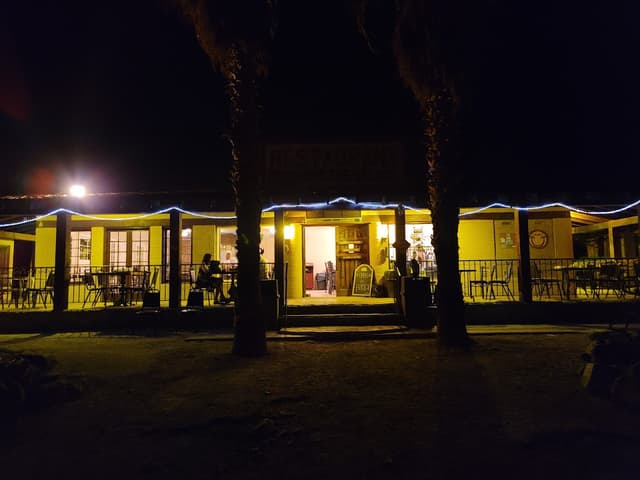
Panamint Springs Resort
@jharrison
This is where we stayed for 4 nights during one of our visits to Death Valley. We loved it. Panamint Springs Resort is a small, rustic, western-style, resort located in beautiful Panamint Valley in Death Valley National Park that provides lodging, camping and RV services, a restaurant and bar, and a gas station with a well stocked general store. Marvelous views of distant sand dunes and the soaring 11,000 foot high Panamint Mountains complete the setting for leisure dining and relaxation.
Add to
Details
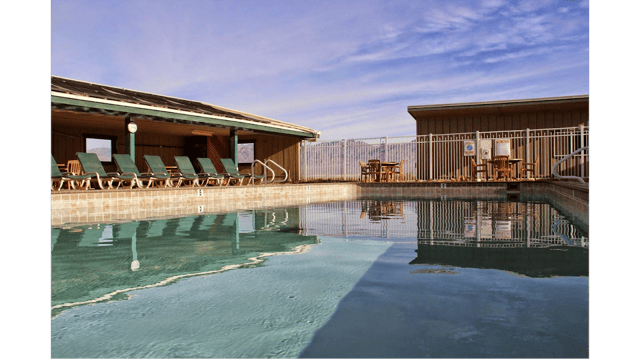
Stovepipe Wells Village Hotel
@jharrison
Stovepipe Wells is in the heart of Death Valley. It is the ultimate destination for adventure travelers. Authentically western, rustic yet comfortable, Stovepipe Wells Village, with its unique hotel, Death Valley restaurant, and Western saloon, has been at the end of the trail for vacationers since 1926. After hiking around the badlands, sand dunes, and canyons, Stovepipe Wells hotels in Death Valley is more than a welcome sight with their friendly, knowledgeable staff, great food, and cold drinks. Stovepipe Wells is very convenient to the Mesquite Dunes and Mosaic Canyon. They are co-located with a restaurant and general store.
Stovepipe Wells offers Hotel Rooms, 14 full-hookup sites, and 190 dry camping sites.
Add to
Details
Where to Stay Outside of Death Valley National Park
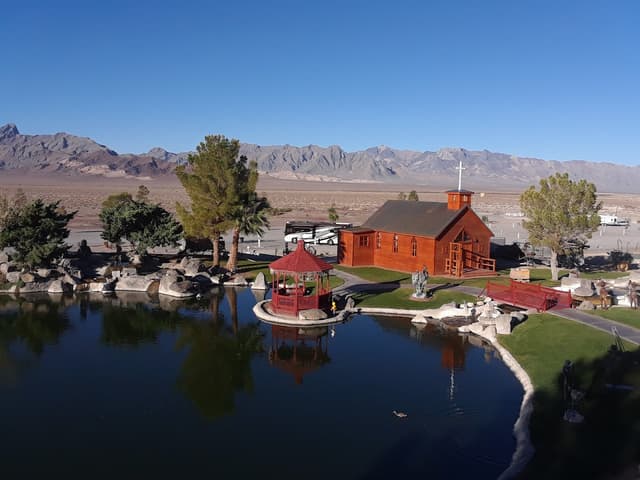
Longstreet Inn Casino & RV Resort
@jharrison
With 60 newly-renovated nonsmoking rooms, accommodations for 51 recreational vehicles and a dynamic casino, Longstreet Inn prides itself on being the most welcoming spot in Nevada. You’ll have everything you need during your stay including two on-site dining options, complimentary high-speed Wi-Fi, free access to the Business Center, a Swimming Pool, 24-hour Casino action, 24-hour Bar, 24-hour Mini Mart, 24-hour Laundry facility, Horse Shoe Pits, and a Petting Zoo!
Add to
Details
Hiking Trails in Death Valley
Hiking with kids
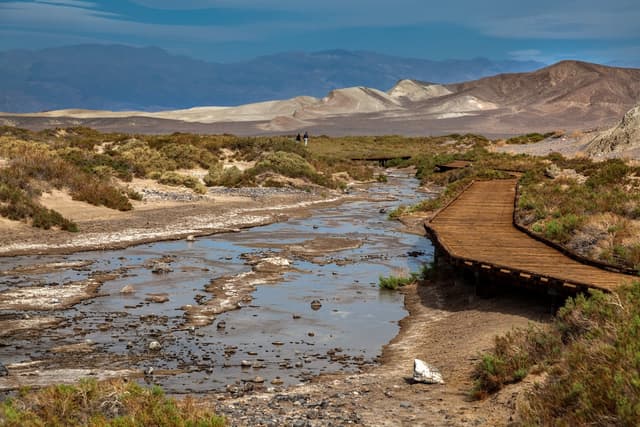
Salt Creek Interpretive Trail
@jharrison
This is an easy 0.5-mile boardwalk trail. The best time to visit is during the Spring (February - April) when the Salt Creek Pupfish are in spawn, but we hiked it in January and it was a gorgeous walk.
Add to
Details
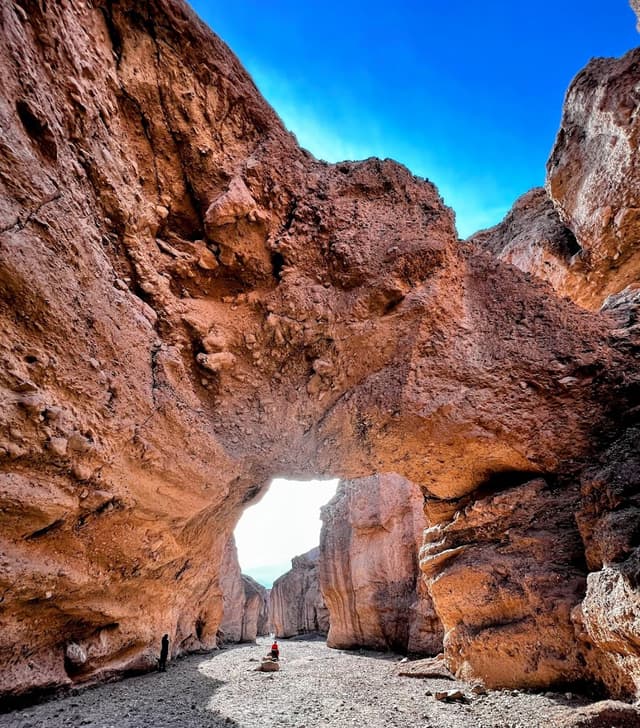
Natural Bridge Trail
@jharrison
This is an easy 1-mile hike that rewards hikers with a walk under a naturally formed bridge. There are also three different spots along this trail where hikers can see the remains of dried waterfalls. This trail has a log of loose gravel and the start of the trail is moderately steep. Walking along this trail feels like walking through a Star Wars Movie.
Add to
Details

Badwater Salt Flats
@jharrison
While this is labeled as a “trail” - it is truly just a walk across the salt flats with no real end. This is the lowest point in North America at 282 feet below sea level. This “hike” is very easy and flat — go out as far as you want and come back when you are ready.
Add to
Details
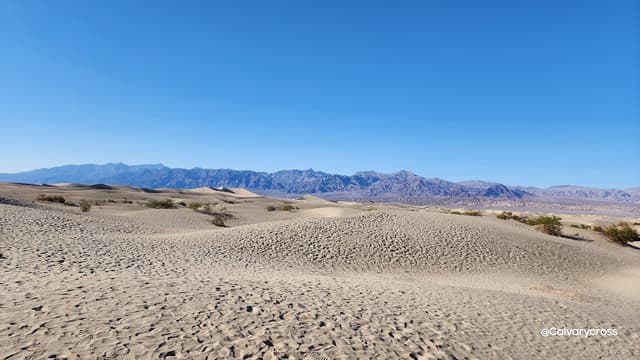
Mesquite Flat Sand Dunes
@jharrison
MUST NOT MISS! This is not a trail per se. Like Badwater Basin, you walk into the dunes as far as you want to go and then back to the car. If you are really ambitious and have quads of steel, head to the peak of High Dunes which is 1 mile (one way) from the parking lot. Come prepared with lots of water and be ready to feel the burn (in your legs).
Add to
Details
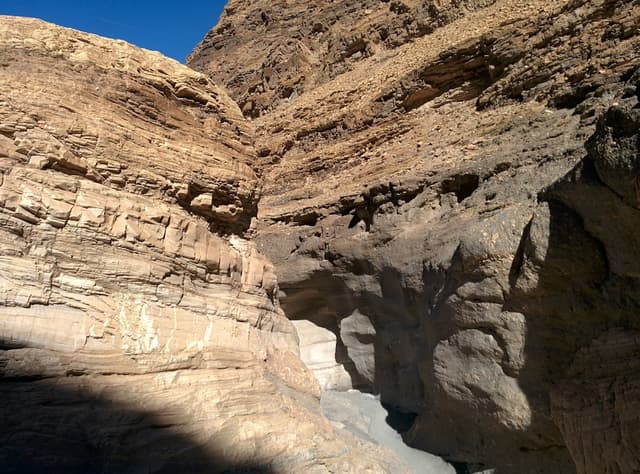
Mosaic Canyon
@jharrison
This is a moderate 3.5-mile trail. The views inside this canyon will make you feel like you’re on another planet. As you hike back out, make sure you slide down the slick rocks. We spent a lot of time letting the kids climb up and slide back down!
There is climbing involved in several spots that I don’t recommend doing with a baby carrier on your back. The climbs were easy enough for younger kids though (with a little help from us).
Add to
Details

Ubehebe Crater Road
@jharrison
This 1.5-mile loop trail takes hikers along the rim of the Ubehebe Crater Loop. Keep your eye out for Little Hebe (a smaller crater) along this path. The views from the top are incredible. We decided to start the loop by going right out of the parking lot. When going this direction you will hike up a steep gravel path and spend the rest going down.
Add to
Details
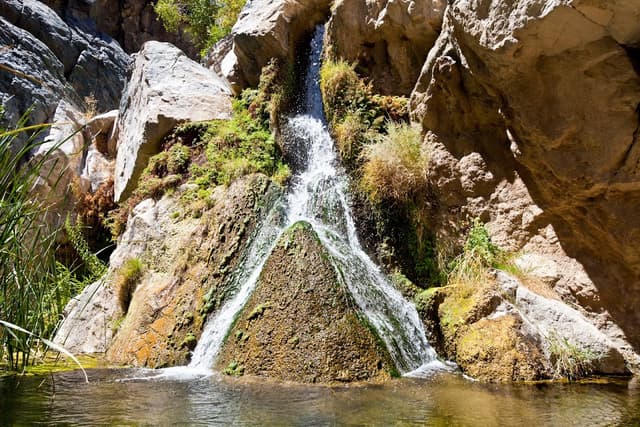
Darwin Falls
@jharrison
This is a moderate 2-mile trail that leads to one of the only lush parts of this entire National Park. The unmarked route is fairly flat but rocky as it transitions from a desert wash into a high-walled canyon. Enjoy this lush oasis in the desert! (This trail is west of Panamint Springs)
Add to
Details
Hiking with Teenagers
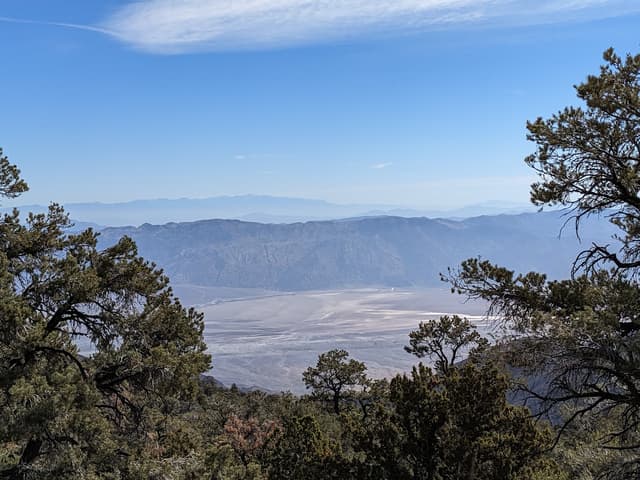
Wildrose Peak Trailhead
@jharrison
This 8.4 mile out and back hike starts directly in front of the Wildrose Charcoal Kilns. Hikers will trek alongside Pinyon Pine and Juniper Trees. As the hike gets higher, hikers will be rewarded with sweeping views of Death Valley. At the very top, there are breathtaking 360* views of the Mojave Desert, Sierra Nevada Mountains, and Death Valley.
Add to
Details
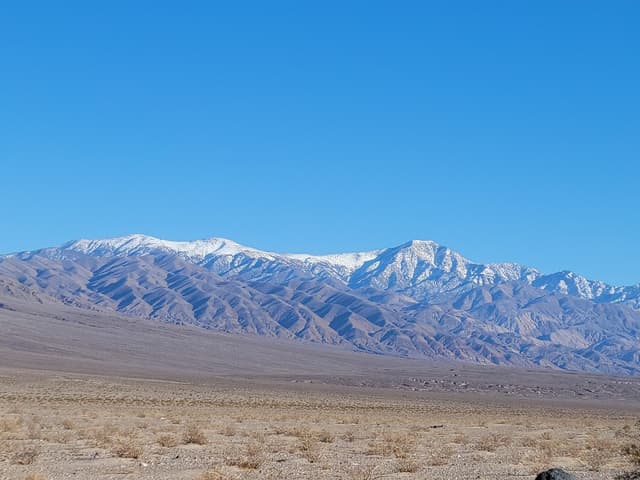
Telescope Peak
@jharrison
This 14 mile out and back trail gains 3,000 feet in elevation, so get ready to feel the leg burn. Mahagony Flat Campground is co-located with the trailhead. As hikers head up the East Panamint Mountain range, they are rewarded with unobstructed views of Death Valley. Near the top, there is a Bristlecone Pine grove and the summit sits at 11,049 feet above sea level.
Add to
Details
What to do in Death Valley National Park with Kids
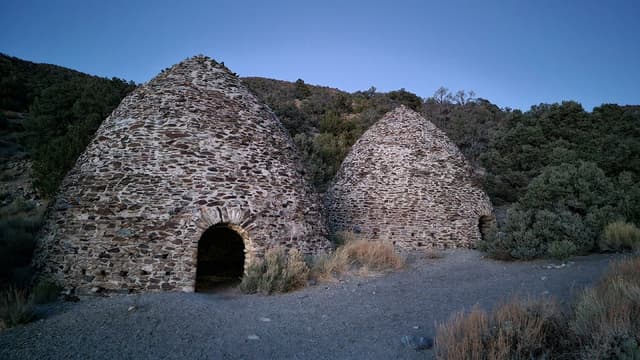
Wildrose Charcoal Kilns
@jharrison
The Wildrose Charcoal Kilns are the most significant historical-architectural features in Death Valley. These structures are 25 feet tall and shaped like beehives. The 10 beehived-shaped Wildrose Kilns are the best know surviving kilns of their kind.
These kilns were completed in 1877 but may have only been used for 2 years in the effort to provide fuel to nearby silver-lead mines.
The drive down to the kilns is absolutely gorgeous. If you’re concerned about the long drive, don’t be. The views and change of terrain are pretty unbelievable. We absolutely loved this drive.
Add to
Details
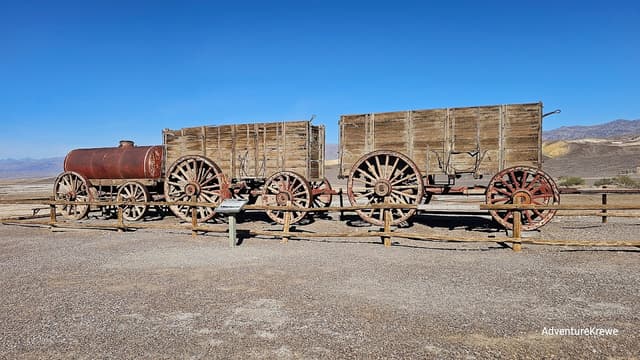
Harmony Borax Works
@jharrison
Harmony Borax Works was the central feature in the opening of Death Valley and the subsequent popularity of the Furnace Creek area. The plant and associated townsite played an important role in Death Valley history. This historic spot has a 0.5 mile ADA Accessible (paved) trail, remains of the old Borax plant, and a well maintained double wagon that was used to haul borax out of Death Valley. Here visitors are able to self guide themselves through the borax processing, the story of the Mule Skinner, and life in Harmony in the 1880s.
Add to
Details
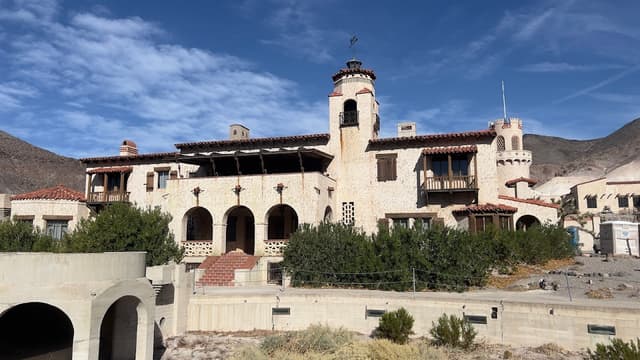
Scotty's Castle
@jharrison
Death Valley Ranch, or Scotty’s Castle, is located in the far North part of Death Valley National Park.
This historic home has an almost unbelievable back story that involves an unlucky gold prospector and a well respected Chicago insurance magnate. The two became unlikely friends and spent many winter trekking Death Valley together. Eventually, they decided to build a more comfortable vacation home to spend their nights in Death Valley, so construction began on the Ranch. However, the Great Depression began to settle in on America and the men realized there was a surveying error on their land, so they halted construction and never began again.
Now, the castle is a coveted piece of interesting history in Death Valley. Unfortunately, a flood caused a lot of damage to the castle and it has been closed since 2015 as they clean up the damage and repair the building.
2024: While the castle remains closed for repairs, limited tours are available with advanced reservation.
Add to
Details
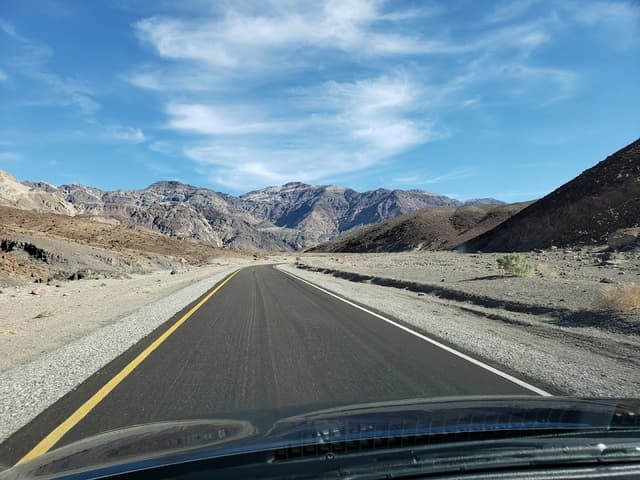
Artists Drive
@jharrison
This 9-mile drive takes visitors through an unbelievable landscape of multi-colored badlands. There is a stop near the beginning to get out and walk up to an overlook. (See image below). You can also stop at Artists Pallette for the famous view of green, pink, purple, and yellow rock formations. Here you can get out and hike along the ridges and valleys of the badlands. There is also a restroom located in the parking lot. This would be an absolutely perfect spot for a picnic with kids! The drive is one-way, so take your time as you maneuver through.
Add to
Details
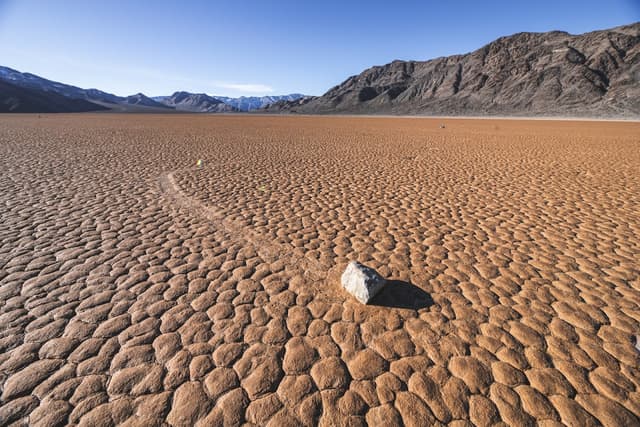
The Racetrack
@jharrison
The Racetrack is a place of otherworldly phenomenon. Rocks move by themselves. This area is a dried lakebed located between 2 mountain ranges. Due to it’s remoteness and difficulty to get to, we did not get to see these for ourselves.
The mysterious moving rocks fascinated scientists for years. It wasn’t until 2014 that the mystery was solved. A perfect combination of cold night time temperatures and warming day temperatures causes the ground to freeze and thaw. This combination lifts the rocks and causes them to slide.
If you decide to head to the Racetrack, please head the NPS warnings.
“The road to the Racetrack is rough, and good tires, 4x4 and high clearance are usually required. Standard rental vehicles are not recommended, and often get flat tires. Use extreme caution on this road in the summer heat. There is no cell phone coverage in the area. Drive time from Furnace Creek is at least 3.5 hours each way. Other access roads make for even longer and more remote adventures.” - NPS
Add to
Details
* * *
ABOUT THE AUTHOR
J Harrison
Available for hire
I’ve always had a love for travel. Growing up, I was lucky enough to hit the road with my grandparents in our trusty travel trailer, touring the USA, Canada, and even Alaska. Those road trips are some of my fondest memories, and now, as a mom, I’m excited to pass that love of travel down to my own kids.
Traveling as a family of six can be a challenge (and let’s be honest, it’s not always cheap!), but I’m always on the lookout for affordable ways to explore, whether it’s a weekend getaway in our SUV or finding ways to make the most of our adventures close to home.
Education is a big part of my travel philosophy. I believe that the best lessons are often learned outside of a classroom, so I try to incorporate learning opportunities into our trips wherever possible. Whether it’s exploring the great outdoors, visiting historical landmarks, or learning about new cultures, I want our kids to experience the world with their own eyes and minds.
I ultimately hope to inspire others to take their own family on adventures, no matter their budget or stage in life.
If I can be of assistance or if you have any questions - I'd love to help.
Send A Tip
Support J Harrison’s work.
Select your tip amount
$5
$10
$20
$50
Or type in other amount
Explore related destinations
Read more about places in this guide
Powered by Thatch
The home for unique & authentic travel
The home for unique & authentic travel
Powered by Thatch: Where great trips are made.
© J Harrison 2025 • Help • Privacy • Terms • Copyright • Become a Seller • Seller Academy • About • Careers • Blog • Explore Places
Ask ThatchGPT
Ask ThatchGPT
Suggest a local expert to plan my trip
Suggest an unique itinerary for my Death Valley National Park, United States trip
What foods do Death Valley National Park, United States locals eat
What are some true hidden gems in Death Valley National Park, United States
Help me brainstorm trip ideas for Death Valley National Park, United States
Help me plan a family-friendly trip to Death Valley National Park, United States